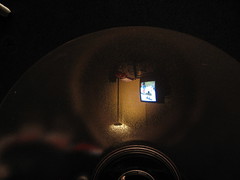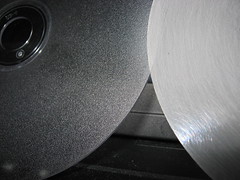
Solution for 52mm
This macro tube was manufactured in India and is sold by a US supplier from Ebay. At $10 plus shipping it was interesting to try. Upon receipt it was confirmed to have a 52mm thread diameter. The threads between spacers is female on the back and male on the front. If you think about a UV filter, you would screw it in with the filter's back thread.
This makes the inner diameter 52mm facing the wrong way. Fortunately 52mm is a standard size. To mate this with the camcorder I bought a 52mm-52mm reverse macro ring. This ring is male 52mm on both sides. SLRs use this to hook up a lens in reverse format to use as a magnifier. From the macro ring, any XXmm to 52mm step up or YYmm to 52mm step down ring can mate with the camcorder lens.
52mm is pretty narrow for focusing screen. The Nikon F3 Type D focus screen barely fits inside the tube. With some art foam I was able to get the screen to fit snug. This pretty much makes the tube suitable for a static design. Note that the tube isn't smooth. The outer diameter of the tube is still 58mm and the inner approximately 55mm. But on either end of each spacer is a 52mm inner thread. Think of a built in step down! Putting a vibrating motor or a holder will be a challenge due to small tolerances.
Source: Ebay - camera_accessories (keywords: nikon tube)
* Spacer 1 6mm
* Spacer 2 12mm
* Spacer 3 24mm
* Outer diameter 58mm
* Inner diameter 52-55mm (ridges)
* Thread diameter 52mm
Solution for 57mm
Perhaps the chinese manufacturer has a 1mm variance. I was really hoping the tube had a standard 58mm thread. But no it had to be 1mm short. Externally the tube is still 58mm. But the connecting threads (male receiving, female connecting) are too short to allow hooking up any sort of reverse ring, filter, or step ring. 57mm isn't a standard filter size. There were filters of this size in the history of single reflex cameras (ancient history in tech terms) such as the Bay 7.5L (maybe sometimes B57) but these don't end in a standard size thread nor are they easy to find. Short of machining one the next best thing is to adapt the thread using a sacrificial 58mm filter or step-up ring.
I go with the filter. Though I have various XXmm to 58mm step up (you can't use a step down because there's not enough contact space) I don't want to get stuck should I need to put a macro in later. So off to Ebay I went to seek the cheapest one with a metal ring. Then off the the hardware store to buy some strong epoxy. I'm still waiting for the filters to arrive, but I plan on removing the glass (minimize internal reflections) before gluing it on.
Source: Ebay - goshotcamera (keywords: nikon macro tube)
* Spacer 1: 9mm
* Spacer 2: 16mm
* Spacer 3: 30mm
* Outer Diameter: 58mm
* Inner Diameter: 54mm
* Thread Diameter: 57mm
So where can you find a tube with a standard 58mm thread? The ones sold from Hong Kong and China are probably a hit or miss deal. I even called Fotodiox and asked a sales representative (they were very accomodating!) to try their tubes if they had 58mm thread and they were just a hair short as well.










